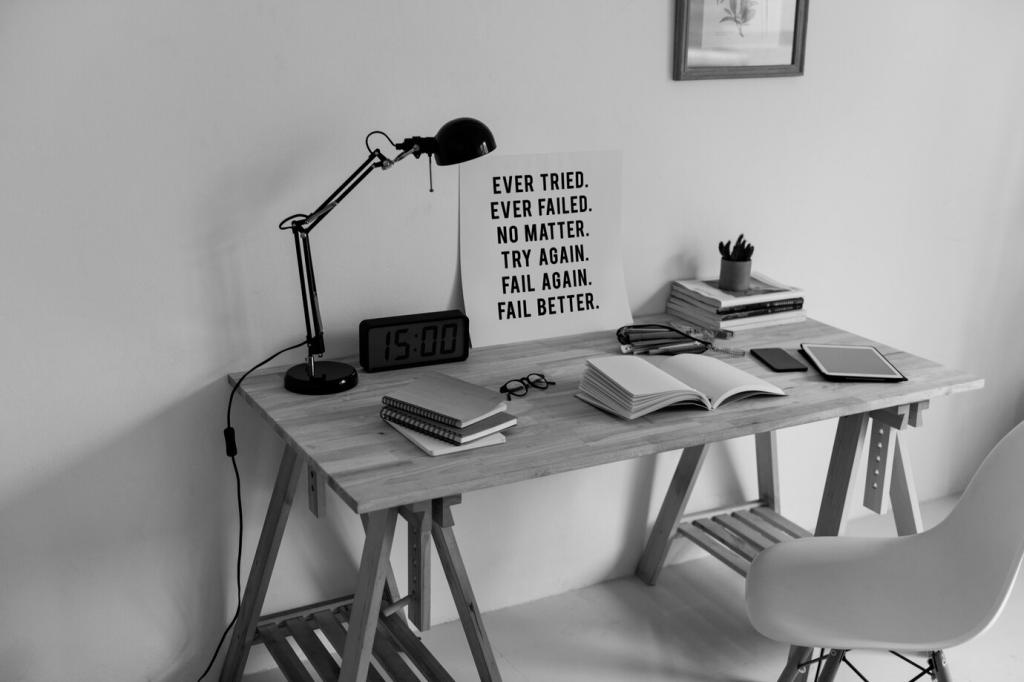Minimalistic Designs for Productivity: Clear Spaces, Sharper Focus
Chosen theme: Minimalistic Designs for Productivity. Strip away visual noise, design with intention, and reclaim your attention. This page invites you to build environments—physical and digital—that reduce friction, amplify clarity, and help you finish what truly matters. Share your thoughts, subscribe for weekly minimalist prompts, and join the conversation.

Why Minimalism Supercharges Productivity
Cognitive Load and Visual Calm
Every extra color, icon, or widget makes your brain evaluate another option. Clean layouts reduce cognitive load, freeing attention for deep work. Calm visuals signal safety, which supports focus, sustained effort, and creative problem-solving throughout demanding blocks of time.
One Decision at a Time
Minimalistic designs present the next best action, not ten competing choices. By surfacing a single priority, you conserve willpower, reduce decision fatigue, and create consistent momentum. The result feels effortless because friction disappears before it can slow you down.
Anecdote: The Two-Notebook Switch
I once kept five notebooks and still lost track of ideas. Switching to two—one capture, one action—transformed my weeks. Fewer containers meant everything had a home, deadlines stopped slipping, and my team trusted my follow-through again.




The One-Screen Rule
Work on a single, intentional screen layout. Pin the task, reference, and notes in predictable places. Avoid window cascades. When everything lives in a stable frame, your eyes learn the map, and your hands move there without hesitation.
App Diet: Fewer Tools, Deeper Mastery
Pick one notes app, one task manager, and one communication channel for most work. Master their shortcuts. Redundancy breeds confusion and lost context, while deep familiarity turns tiny actions into a fast, satisfying rhythm.
Notifications with Intent
Silence badges and banners by default. Allow only calendar alerts and urgent mentions. Batch the rest. Your attention belongs to the task, not the feed. Comment below with your own notification rules and subscribe for more focused workflows.
Typography and Layout for Focus
Whitespace is not empty; it is guidance. Use consistent margins and line spacing to create breathing room around key ideas. The eye appreciates predictable pauses, making long reading and precise editing far more sustainable.

Five-Minute Reset
End each session by resetting the space: close loops, file loose notes, clear the desktop. Five minutes now saves fifteen later. Share your reset ritual in the comments and inspire other readers to try it tonight.
Time-Boxing with Breathing Room
Schedule focused sprints with short buffers between blocks. Minimal design respects energy cycles. Protect your buffers fiercely, and your calendar becomes a calm runway instead of a frantic obstacle course.
The Done List
Keep a minimalist done list capturing completed outcomes, not busywork. Seeing meaningful progress keeps momentum high and curbs the urge to complicate systems. It is simple, satisfying, and surprisingly motivating.
Minimalism for Teams
01
Shared Visual Standards
Create a tiny design system: colors, spacing, type tokens, and component examples on one page. Less debate, more building. New teammates ramp faster when decisions are already made thoughtfully and documented clearly.
02
Simplified Decision Trees
Agree on default paths. If X, then Y. Escalate only when necessary. Decision trees save meetings by resolving routine choices silently, letting your team spend its attention on genuine strategy, not procedural friction.
03
Meeting Pages with Purpose
Replace slide decks with single-page briefs: purpose, context, options, decision. Minimal format, maximum clarity. Ask your team to test this for two weeks and report results below. Subscribe to learn how to measure the impact.
Start Today: A 7-Day Minimalism Sprint
Remove fifteen items from your desk, then redesign your layout around a single focal point. Photograph the before and after. Share your photos in the comments to encourage others to start reshaping their space.
